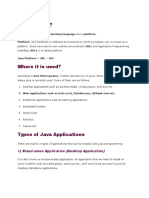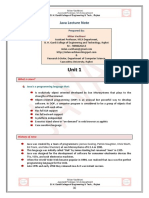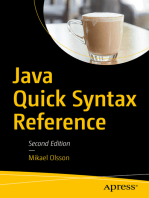Notes1 Introduction To Java
Uploaded by
seniorhigh LISNotes1 Introduction To Java
Uploaded by
seniorhigh LISIntroduction to Java
1.1 Objectives
In this section, we will be discussing a little bit of Java history and what is Java Technology. We will also
discuss the phases that a Java program undergoes.
At the end of the lesson, the student should be able to:
Describe the features of Java technology such as the Java virtual machine, garbage collection and
code security
Describe the different phases of a Java program
1.2 Java Background
1.2.1 A little Bit of History
Java was created in 1991 by James Gosling et al. of Sun Microsystems. Initially called Oak, in honor of the
tree outside Gosling's window, its name was changed to Java because there was already a language called
Oak.
The original motivation for Java was the need for platform independent language that could be embedded
in various consumer electronic products like toasters and refrigerators. One of the first projects developed
using Java was a personal hand-held remote control named Star 7.
At about the same time, the World Wide Web and the Internet were gaining popularity. Gosling et. al.
realized that Java could be used for Internet programming.
1.2.2 What is Java Technology?
1.2.2.1 A programming language
As a programming language, Java can create all kinds of applications that you could create using any
conventional programming language.
1.2.2.2 A development environment
As a development environment, Java technology provides you with a large suite of tools: a compiler,
an interpreter, a documentation generator, a class file packaging tool, and so on.
1.2.2.3 An application environment
Java technology applications are typically general-purpose programs that run on any machine where the
Java runtime environment (JRE) is installed.
1.2.2.4 A deployment environment
There are two main deployment environments: First, the JRE supplied by the Java 2 Software
Development Kit (SDK) contains the complete set of class files for all the Java technology packages, which
includes basic language classes, GUI component classes, and so on. The other main deployment
environment is on your web browser. Most commercial browsers supply a Java technology interpreter
and runtime environment.
Introduction to Programming III JEDI theboi 1
1.2.3 Some Features of Java
1.2.3.1 The Java Virtual Machine
The Java Virtual Machine is an imaginary machine that is implemented by emulating software on a real
machine. The JVM provides the hardware platform specifications to which you compile all Java technology
code. This specification enables the Java software to be platform-independent because the compilation is
done for a generic machine known as the JVM.
A bytecode is a special machine language that can be understood by the Java Virtual Machine (JVM).
The bytecode is independent of any particular computer hardware, so any computer with a Java
interpreter can execute the compiled Java program, no matter what type of computer the program was
compiled on.
1.2.3.2 Garbage Collection
Many programming languages allows a programmer to allocate memory during runtime. However, after
using that allocated memory, there should be a way to deallocate that memory block in order for other
programs to use it again. In C, C++ and other languages the programmer is responsible for this. This can
be difficult at times since there can be instances wherein the programmers forget to deallocate memory
and therefor result to what we call memory leaks.
In Java, the programmer is freed from the burden of having to deallocate that memory themselves by
having what we call the garbage collection thread. The garbage collection thread is responsible for
freeing any memory that can be freed. This happens automatically during the lifetime of the Java
program.
1.2.3.3 Code Security
Code security is attained in Java through the implementation of its Java Runtime Environment (JRE).
The JRE runs code compiled for a JVM and performs class loading (through the class loader), code
verification (through the bytecode verifier) and finally code execution.
The Class Loader is responsible for loading all classes needed for the Java program. It adds security by
separating the namespaces for the classes of the local file system from those that are imported from
network sources. This limits any Trojan horse applications since local classes are always loaded first. After
loading all the classes, the memory layout of the executable is then determined. This adds protection
against unauthorized access to restricted areas of the code since the memory layout is determined during
runtime.
After loading the class and layouting of memory, the bytecode verifier then tests the format of the code
fragments and checks the code fragments for illegal code that can violate access rights to objects.
After all of these have been done, the code is then finally executed.
1.2.4 Phases of a Java Program
The following figure describes the process of compiling and executing a Java program.
Figure 1: Phases of a Java Program
The first step in creating a Java program is by writing your programs in a text editor. Examples of text
Introduction to Programming III JEDI theboi 2
editors you can use are notepad, vi, emacs, etc. This file is stored in a disk file with the extension .java.
After creating and saving your Java program, compile the program by using the Java Compiler. The output
of this process is a file of Java bytecodes with the file extension .class.
The .class file is then interpreted by the Java interpreter that converts the bytecodes into the machine
language of the particular computer you are using.
Task Tool to use Output
Write the program Any text editor File with .java extension
Compile the program Java Compiler File with .class extension
(Java bytecodes)
Run the program Java Interpreter Program Output
Table 1: Summary of Phases of a Java Program
Introduction to Programming III JEDI theboi 3
You might also like
- JEDI Slides Intro1 Chapter 02 Introduction To JavaNo ratings yetJEDI Slides Intro1 Chapter 02 Introduction To Java17 pages
- Chapter 1: Get Started and Sip Your First Java Cup... (4.5 HRS) Chapter ObjectiveNo ratings yetChapter 1: Get Started and Sip Your First Java Cup... (4.5 HRS) Chapter Objective8 pages
- Chapter 1: Get Started and Sip Your First Java Cup... (4.5 HRS) Chapter ObjectiveNo ratings yetChapter 1: Get Started and Sip Your First Java Cup... (4.5 HRS) Chapter Objective9 pages
- APznzabS03alwV8LTFhBXk0Zpo-bTMxhar8K5WMTvRjHFpHIccmiJDDopbQS1eavm3fHgOxo-DBiKupZ_i88fSnZJ33kJsSLxWcVGqLHx8...GGlMcaDzM3X7tsIRPy8Fj4dXuVbf8LLPpj2Z0ROZ7veJL6sGP66Lsz_iocuDbuXAGKc_R0llENXlC_wiawaAI1OS5lvFF_GrY3BlKBYDQ0yWLHsV0PbTTPZ6BmNo ratings yetAPznzabS03alwV8LTFhBXk0Zpo-bTMxhar8K5WMTvRjHFpHIccmiJDDopbQS1eavm3fHgOxo-DBiKupZ_i88fSnZJ33kJsSLxWcVGqLHx8...GGlMcaDzM3X7tsIRPy8Fj4dXuVbf8LLPpj2Z0ROZ7veJL6sGP66Lsz_iocuDbuXAGKc_R0llENXlC_wiawaAI1OS5lvFF_GrY3BlKBYDQ0yWLHsV0PbTTPZ6Bm64 pages
- Norsaremah Salleh, PHD.: Introduction To Java Program DevelopmentNo ratings yetNorsaremah Salleh, PHD.: Introduction To Java Program Development15 pages
- Core Java With JSP Unit - 1 Chapter - 1. Introduction HistoryNo ratings yetCore Java With JSP Unit - 1 Chapter - 1. Introduction History13 pages
- Introduction To Java Programming - TutorialNo ratings yetIntroduction To Java Programming - Tutorial89 pages
- Introduction To Programming: Sheikh Qaisar Ayub, Sulma RashidNo ratings yetIntroduction To Programming: Sheikh Qaisar Ayub, Sulma Rashid24 pages
- Core Java Full Notes by kiran @satya technologiesNo ratings yetCore Java Full Notes by kiran @satya technologies368 pages
- 2018 Lecture 1 - Introduction To Java PDFNo ratings yet2018 Lecture 1 - Introduction To Java PDF21 pages
- DCIT 22 Computer Programming 1 Lecture 3No ratings yetDCIT 22 Computer Programming 1 Lecture 322 pages
- Prog 731 Java Topic 1 (Introduction of Java Language and Oop)No ratings yetProg 731 Java Topic 1 (Introduction of Java Language and Oop)29 pages
- Java Basics : Your Comprehensive Guide to Programming with Ease and Confidence from Scratch to Advanced ConceptsFrom EverandJava Basics : Your Comprehensive Guide to Programming with Ease and Confidence from Scratch to Advanced ConceptsNo ratings yet
- The JVM Handbook: A Developer’s Guide to Java Virtual MachineFrom EverandThe JVM Handbook: A Developer’s Guide to Java Virtual MachineNo ratings yet
- JAVA: Java Programming for beginners teaching you basic to advanced JAVA programming skills!From EverandJAVA: Java Programming for beginners teaching you basic to advanced JAVA programming skills!No ratings yet
- Certification: Muñoz National High School-Main (Senior High School)No ratings yetCertification: Muñoz National High School-Main (Senior High School)4 pages
- Certificate of Employment - Senior High SchoolNo ratings yetCertificate of Employment - Senior High School2 pages
- JS03 Frequency Modulation Using Multisim Hanif AziziNo ratings yetJS03 Frequency Modulation Using Multisim Hanif Azizi4 pages
- Volcanic Versus Anthropogenic Carbon Dioxide (2011 EOS) PDFNo ratings yetVolcanic Versus Anthropogenic Carbon Dioxide (2011 EOS) PDF3 pages
- Topic 1. Measurement of Physical Quantities (Notes)100% (1)Topic 1. Measurement of Physical Quantities (Notes)9 pages
- Stock Price Prediction Using Genetic AlgorithmsNo ratings yetStock Price Prediction Using Genetic Algorithms3 pages
- Experimental Stress Analysis Important QuestionsNo ratings yetExperimental Stress Analysis Important Questions4 pages
- Lab Experiment # 4: To Analyze and Verify The Half Wave and Full Wave Bridge RectificationNo ratings yetLab Experiment # 4: To Analyze and Verify The Half Wave and Full Wave Bridge Rectification6 pages
- POW KEEPER Series User Manual Bb3569ba b8fb 44af b705 Ef13f9c0da9eNo ratings yetPOW KEEPER Series User Manual Bb3569ba b8fb 44af b705 Ef13f9c0da9e15 pages
- Sound Waves and Acoustic Emission 1st Edition Claudia Barile download pdf100% (4)Sound Waves and Acoustic Emission 1st Edition Claudia Barile download pdf40 pages
- Piezoelectric Ceramics: Electro Ceramic SolutionsNo ratings yetPiezoelectric Ceramics: Electro Ceramic Solutions11 pages
- General Law of Gravitation: Physics: Grade 2, Semester 1No ratings yetGeneral Law of Gravitation: Physics: Grade 2, Semester 115 pages
- 31 JAN 2025 FUNCTIONS and INVERSES GR 12No ratings yet31 JAN 2025 FUNCTIONS and INVERSES GR 1217 pages
- Geophysical Hazards. Minimizing Risk, Maximizing Awareness (Tom Beer)No ratings yetGeophysical Hazards. Minimizing Risk, Maximizing Awareness (Tom Beer)176 pages
































































































